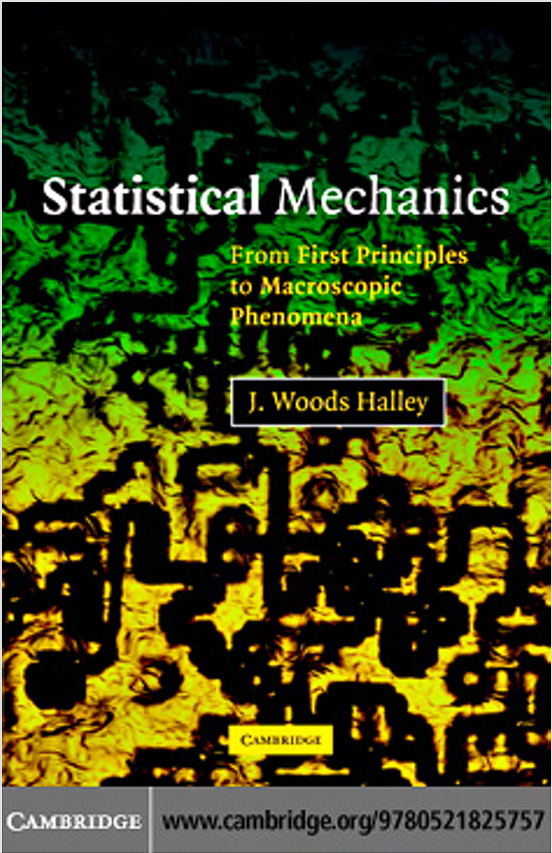
STATISTICAL MECHANICS From First Principles to Macroscopic Phenomena
Author: J . WOODS HALLEY Category: Matematika Terapan dalam Fisika, Statistika dan Mekanika Kuantum Publisher: Cambridge University Press ISBN: 978-0-511-25636-3This book is based on a course which I have taught over many years to graduate
students in several physics departments. Students have been mainly candidates
for physics degrees but have included a scattering of people from other departments
including chemical engineering, materials science and chemistry. I take a
“reductionist” view, that implicitly assumes that the basic program of physics of
complex systems is to connect observed phenomena to fundamental physical laws as
represented at the molecular level by Newtonian mechanics or quantum mechanics.
While this program has historically motivatedworkers in statistical physics for more
than a century, it is no longer universally regarded as central by all distinguished
users of statistical mechanics1,2 some of whom emphasize the phenomenological
role of statistical methods in organizing data at macroscopic length and time scales
with only qualitative, and often only passing, reference to the underlying microscopic
physics. While some very useful methods and insights have resulted from
such approaches, they generally tend to have little quantitative predictive power.
Further, the recent advances in first principles quantum mechanical methods have
put the program of predictive quantitative methods based on first principles within
reach for a broader range of systems. Thus a text which emphasizes connections to
these first principles can be useful.
The level here is similar to that of popular books such as those by Landau and
Lifshitz,3 Huang4 and Reichl.5 The aim is to provide a basic understanding of
the fundamentals and some pivotal applications in the brief space of a year. With
regard to fundamentals, I have sought to present a clear, coherent point of view
which is correct without oversimplifying or avoiding mention of aspects which are
incompletely understood. This differs from many other books, which often either
give the fundamentals extremely short shrift, on the one hand, or, on the other,
expend more mathematical and scholarly attention on them than is appropriate in a
one year graduate course. The chapters on fundamentals begin with a description
of equilibrium for classical systems followed by a similar description for quantum
ix
x Preface
mechanical systems. The derivation of the equilibrium aspects of thermodynamics
is then presented followed by a discussion of the semiclassical limit.
In the second part, I progress through equilibrium applications to successively
more dense states of matter: ideal classical gases, ideal quantum gases, imperfect
classical gases (cluster expansions), classical liquids (including molecular dynamics)
and some aspects of solids. A detailed discussion of solids is avoided because,
at many institutions, solid state physics is a separate graduate course. However,
because magnetic models have played such a central role in statistical mechanics,
they are not neglected here. Finally, in this second part, having touched on the
main states of matter, I devote a chapter to phase transitions: thermodynamics,
classification and the renormalization group.
The third part is devoted to dynamics. This consists first of a long chapter on
the derivation of the equations of hydrodynamics. In this chapter, the fluctuation–
dissipation theorem then appears in the form of relations of transport coefficients to
dynamic correlation functions. The second chapter of the last part treats stochastic
models of dynamics and dynamical aspects of critical phenomena.
There are problems in each chapter. Solutions are provided for many of them in
an appendix. Many of the problems require some numerical work. Sample codes
are provided in some of the solutions (in Fortran) but, in most cases, it is advisable
for students to work out their own solutions which means writing their own codes.
Unfortunately, the students I have encountered recently are still often surprised to
be asked to do this but there is really no substitute for it if one wants a thorough
mastery of simulation aspects of the subject.
I have interacted with a great many people and sources during the evolution of this
work. For this reason acknowledging them all is difficult and I apologise in advance
if I overlook someone. My tutelage in statistical mechanics began with a course
by Allan Kaufman in Berkeley in the 1960s. With regard to statistical mechanics I
have profited especially from interactions with Michael Gillan, Gregory Wannier
(some personally but mainly from his book), Mike Thorpe, Aneesur Rahman, Bert
Halperin, Gene Mazenko, Hisao Nakanishi, Nigel Goldenfeld and David Chandler.
Obviously none of these people are responsible for any mistakes you may find, but
they may be given some credit for some of the good stuff. I am also grateful to
the many classes that were subjected to these materials, in rather unpolished form
in the early days, and who taught me a lot. Finally I thank all my Ph.D. students
and postdocs (more than 30 in all) through the years for being good company and
colleagues and for stimulating me in many ways.
J. Woods Halley
Minneapolis
July 2005
Preface xi
References
1. For example, P. Anderson, Seminar 8 in http://www.princeton.edu/complex/site/
2. P. Anderson, A Career in Theoretical Physics, London: World Scientific, 1994.
3. L. D. Landau and E. M. Lifshitz, Statistical Physics, 3rd edition, Part 1, Course of
Theoretical Physics, Volume 5, Oxford: Pergamon Press, 1980.
4. K. Huang, Statistical Mechanics, New York: John Wiley, 1987.
5. L. E. Reichl, A Modern Course in Statistical Physics, 2nd edition, New York: John
Wiley, 1998.
Back